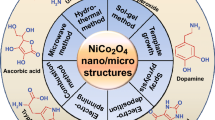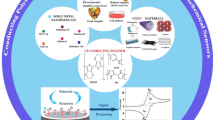Abstract
A composite was prepared from copper and graphene oxide (Cu-GO) by in-situ chemical reduction of a mixture containing GO and Cu(II) ions with potassium borohydride. The morphology and structure of the composite were confirmed by various physicochemical techniques. The materials were used in a tyrosinase-based microbiosensor where the enzyme is immobilized in a biocompatible matrix consisting of poly(ortho-phenylene diamine) and Cu-GO. The composite was deposited on the surface of an 8-μm thick carbon fiber microelectrode. The role of each component in the sensing layer was systematically investigated with respect to the analytical performance of the system. In its optimal configuration, the biosensor demonstrated (a) a sensitivity of 6.1 ± 3 nA mM-1 dopamine (DA), (b) a linear response to DA (with a Michaelis-Menten constant of 0.29 ± 0.03 mM), (c) good selectivity over ascorbic acid and uric acid, and (d) a high blocking capacity (112.2 ± 2 mM) for ascorbic acid.

Poly(o-phenylenediamine) electropolymerized carbon fiber electrode with sensitivity towards dopamine (DA) is 6.1 ± 3 nA mM−1 supported by Cu-GO. The linear range for DA is 0.29 ± 0.03 mM with 0.033 μM LOD and fast response time of <8 s with ascorbic acid blocking capacity of 112.2 ± 2 mM AA. Studies on different ratio of Glu/Tyr revealed that 10:3 gave best overall response.



Similar content being viewed by others
References
Robinson DL, Venton BJ, Heien MLAV, Wightman RM (2003) Detecting subsecond dopamine release with fast-scan cyclic voltammetry in vivo. Clin Chem 49:1763–1773
Hefco V, Yamada K, Hefco A, Hritcu L, Tiron A, Nabeshima T (2003) Role of the mesotelencephalic dopamine system in learning and memory processes in the rat. Eur J Pharmacol 475:55–60
Swamy BEK, Venton BJ (2007) Carbon nanotube-modified microelectrodes for simultaneous detection of dopamine and serotonin in vivo. Analyst 132:876–884
Wightman RM, May LJ, Michael AC (2008) Detection of dopamine dynamics in the brain. Anal Chem 60:769A–779A
Hernandez G, Shizgal P (2009) Dynamic changes in dopamine tone during self-stimulation of the ventral tegmental area in rats. Behav Brain Res 198:91–97
Sanghavi BJ, Mobina SM, Mathur P, Lahiri GK, Srivastavaa AK (2013) Biomimetic sensor for certain catecholamines employing copper(II) complex and silver nanoparticle modified glassy carbon paste electrode. Biosens Bioelectron 39:124–132
Myers RD, Adell A, Lankford MF (1998) Simultaneous comparison of cerebral dialysis and push-pull perfusion in the brain of rats: A critical review. Neurosci Biobehav Rev 22:371–387
Nikolelis DP, Drivelos DA, Simantiraki MG, Koinis S (2004) An optical spot test for the detection of dopamine in human urine using stabilized in air lipid films. Anal Chem 76:2174–2180
Sabbioni C, Saracino MA, Mandrioli R, Pinzauti S, Furlanetto S, Gerra G, Raggi MA (2004) Simultaneous liquid chromatographic analysis of catecholamines and 4-hydroxy-3-methoxyphenylethylene glycol in human plasma—comparison of amperometric and coulometric detection. J Chromatogr A 1032:65–71
Yavich L, Tiihonen (2004) Patterns of dopamine overflow in mouse nucleus accumbens during intracranial self-stimulation. J Neurosci Lett 293:41–44
Valentini F, Palleschi G, Lopez Morales E, Orlanducci S, Tamburri E, Terranova ML (2007) Functionalized single-walled carbon nanotubes modified microsensors for the selective response of epinephrine in presence of ascorbic acid. Electroanalysis 19:859–869
Cheer JF, Wassum KM, Sombers LA, Heien MLAV, Ariansen JL, Aragona BJ, Phillips PEM, Wightman RM (2007) Phasic dopamine release evoked by abused substances requires cannabinoid receptor activation. J Neurosci 27:791–795
Cao X, Luo L, Ding Y, Zou X, Bian R (2008) Electrochemical methods for simultaneous determination of dopamine and ascorbic acid using cetylpyridine bromide/chitosan composite film-modified glassy carbon electrode. Sensors Actuators B 129:941–946
Zou X, Luo L, Ding Y, Wu Q (2007) Chitosan incorporating cetyltrimethylammonium bromide modified glassy carbon electrode for simultaneous determination of ascorbic acid and dopamine. Electroanalysis 19:1840–1844
Kang TF, Shen GL, Yu RQ (1997) Voltammetric behaviour of dopamine at nickel phthalocyanine polymer modified electrodes and analytical applications. Anal Chim Acta 354:343–349
Jeong H, Jeon S (2008) Determination of dopamine in the presence of ascorbic acid by Nafion and single-walled carbon nanotube film modified on carbon fiber microelectrode. Sensors 8:6924–6935
Castro SSL, Mortimer RJ, de Oliveira MF, Stradiotto NR (2008) Electrooxidation and determination of dopamine using a Nafion (R)-cobalt hexacyanoferrate film modified electrode. Sensors 8:1950–1959
Andreescu S, Sadik OA (2004) Correlation of analyte structures with biosensor responses using the detection of phenolic estrogens as a model. Anal Chem 76:552–560
Liu A, Honma I, Zhou H (2005) Amperometric biosensor based on tyrosinase-conjugated polysacchride hybrid film: Selective determination of nanomolar neurotransmitters metabolite of 3,4-dihydroxyphenylacetic acid (DOPAC) in biological fluid. Biosens Bioelectron 21:809–816
Gan T, Hu S (2011) Electrochemical sensors based on graphene materials. Microchim Acta 175:1–19
Yang X, Feng B, He X, Li F, Ding Y, Fei J (2013) Carbon nanomaterial based electrochemical sensors for biogenic amines. Microchim Acta 180:935–956
Kovtyukhova NI, Ollivier PJ, Martin BR, Mallouk TE, Chizhik SA, Buzaneva EV, Gorchinskiy AD (1999) Layer-by-layer assembly of ultrathin composite films from micron-size graphite oxide sheets and polycations, chemistry of materials. Chem Mater 11:771–778
Inoue T, Kirchhoff JR, Hudson RA (2002) Enhanced measurement stability and selectivity for choline and acetylcholine by capillary electrophoresis with electrochemical detection at a covalently linked enzyme modified electrode. Anal Chem 74:5321–5326
Rahman MM, Khan SB, Asiri AM, Marwani HM, Qusti AH (2013) Selective detection of toxic Pb(II) ions based on wet-chemically prepared nanosheets integrated CuO-ZnO nanocomposites. Compos Part B 54:215–223
Karim MR, Shinoda H, Nakai M, Hatakeyama K, Kamihata H, Matsui T, Taniguchi T, Koinuma M, Kuroiwa K, Kurmoo M, Matsumoto Y, Hayami S (2013) Electrical conductivity and ferromagnetism in a reduced graphene-metal oxide hybrid. Adv Funct Mater 23:323–332
Rahman MM, Khan SB, Faisal M, Rub MA, Al-Youbi AO, Asiri AM (2012) Electrochemical determination of olmesartan medoxomil using hydrothermally prepared nanoparticles composed SnO2–Co3O4 nanocubes in tablet dosage forms. Talanta 99:924–931
Duval C (1963) Thermogravimetric analysis. Elsevier, Amsterdam, p 315
Rao CNR (1963) Chemical applications of infrared spectroscopy. Academic, New York, p 355
Stankovich S, Dikin DA, Piner RD, Kohlhaas KA, Kleinhammes A, Jia Y, Wu Y, Guyen ST, Ruoff RS (2007) Synthesis of graphene-based nanosheets via chemical reduction of exfoliated graphite oxide. Carbon 45:1558–1565
Chen Q, Zhang L, Chen G (2012) Facile preparation of graphene-copper nanoparticle composite by in situ chemical reduction for electrochemical sensing of carbohydrates. Anal Chem 84:171–178
Gouda MD, Thakur MS, Karanth NG (2001) Stability studies on immobilized glucose oxidase using an amperometric biosensor-effect of protein based stabilizing agents. Electroanalysis 13:849–855
O’Neill RD, Lowry JP, Rocchitta G, McMahon CP, Serra PA (2008) Designing sensitive and selective polymer/enzyme composite biosensors for brain monitoring in vivo. Trends Anal Chem 27:78–88
Rothwell SA, Kinsella ME, Zain ZM, Serra PA, Rocchitta G, Lowry JP, O’Neill RD (2009) Contributions by a novel edge effect to the permselectivity of an electrosynthesized polymer for microbiosensor applications. Anal Chem 81:3911–3918
Zain ZM, O’Neill RD, Lowry JP, Pierce KW, Tricklebank M, Dewa A, Ghani SA (2010) Development of an potentially implantable D-serine biosensor for in vivo monitoring using mammalian D-amino acid oxidase on a poly (o-phenylenediamine) and nafion-modified platinum-iridium disk electrode. Biosens Bioelectron 25:1454–1459
McMahon CP, O’Neill RD (2005) Polymer-enzyme composite biosensor with high glutamate sensitivity and low oxygen dependence. Anal Chem 77:1196–1199
Acknowledgments
This Project was funded by the Deanship of Scientific Research (DSR), King Abdulaziz University, Jeddah, under grant no. 326/130/1433. The authors, therefore, acknowledge with thanks DSR technical and financial support.
Author information
Authors and Affiliations
Corresponding author
Electronic supplementary material
Below is the link to the electronic supplementary material.
ESM 1
(PDF 492 kb)
Rights and permissions
About this article
Cite this article
Khan, A., Khan, A.A.P., Asiri, A.M. et al. In vitro studies of carbon fiber microbiosensor for dopamine neurotransmitter supported by copper-graphene oxide composite. Microchim Acta 181, 1049–1057 (2014). https://doi.org/10.1007/s00604-014-1202-0
Received:
Accepted:
Published:
Issue Date:
DOI: https://doi.org/10.1007/s00604-014-1202-0




